Skateboarding is more than just a sport—it’s a lifestyle, and the skateboard deck you choose plays an integral role in your skateboard performance. But with countless skateboard deck options, how do you know which skateboard is right for you? We’re here to help demystify this process through our skateboard deck purchasing guide. Here are useful tips for purchasing a deck for your skateboard. The key is making the right decision to ensure that you get your money’s worth.
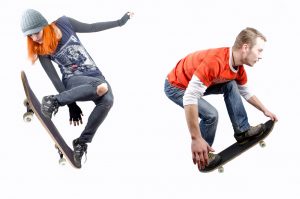
Skateboard Deck
So whether you’re a seasoned pro or just starting on your street skating journey, stick with us! We’ve got your back as we navigate this exciting terrain together—you don’t have to go it alone. Let’s embark on this adventure and find the perfect skateboard deck that will serve not only you but also those around you!
Skate Deck And Flip Tricks
Before you’re swept up in the excitement of purchasing your first skateboard deck, it’s vital to understand the nose and tail deck basics – they’ll make all the difference in your skateboarding experience.
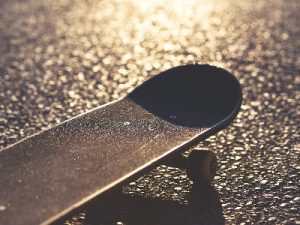
Deck maintenance, skateboard artistry, and finding the perfect skate size for optimal performance are key elements that contribute to a fulfilling skateboarding experience. Here at FamilyHype, we believe in helping others find their skate and want to ensure that you get the most out of your skateboarding style. Now, let’s explore how to choose a board with the right deck size for optimal nose and tail deck performance.
The skateboard deck is the most important component of the skate, so it’s important to consider the deck width, deck length, and shape of the skateboard deck to ensure maximum maneuverability. Don’t forget to check the grip tape for traction, especially when you’re practicing tricks on ramps & rails. Additionally, complement your skate style with shirts & hoodies and hats & beanies to complete your look. Whether you’re choosing a board for street skating or cruising, finding the right skateboard size and shape is crucial for an optimal skateboarding experience.
Guide To Skateboard Deck Size
Choosing a skateboard deck that is the perfect size for your ride is essential for your comfort and skateboarding performance. Just like finding the perfect pair of jeans, finding the right size skateboard deck is key. Just follow this guideline.
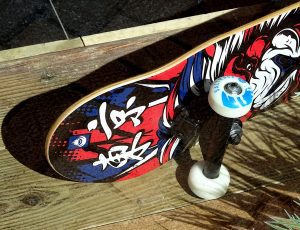
To get the ideal fit, the skateboard size of the deck should match the weight of the skateboarder. Not only should the size be on point, but larger wheels and deck graphics should add riding style to the function. When you’re comfortable, you’ll be able to serve others better. And when it comes to skating, you’ll be able to ride better on a longboard that’s the right size.
Selecting The Perfect Skateboard Deck Shape
At FamilyHype, we’re here to help elevate your skating experience. So let’s delve into an essential aspect of skating: finding the perfect shape for your skateboarding experience.
Actual rules apply when choosing deck shape. A wider board or a wide board is better for bigger feet. A longer deck length and wheelbase is ideal for technical maneuvers. Check the skateboard size chart, nose and tail turning radius information, and common construction. Additionally, ensure you have the right grip tape for better traction and control, especially when practicing tricks on ramps & rails. When you choose a board, consider not only the shape and size but also how your shirts & hoodies and overall style will complement your skating gear.
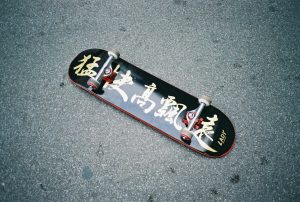
Deck width size is important, but your rough surface skating style takes precedence. Whether you favor a wider nose and tail for technical stability or a narrower profile for maneuverability, finding the right balance is key. From purchasing classic popsicle shapes to old-school fishtails, and finding the right shoe size for street skating, there’s something for everyone.
Board shapes include the board, street, bowl, and cruiser board decks. Each has its own set of characteristics and features. Choose a deck wisely – we want you to have the best skating experience possible.
Skateboard Deck Materials Matter
Now that we’ve discussed how to select the perfect shape for your board, let’s examine another crucial aspect—the material. When selecting a skateboard, it’s important to consider the skateboard size chart, turning radius information, and common construction materials and methods
It’s no secret that the materials used in your board, such as maple decks, significantly impact its durability and performance. We’ll explore common materials and discuss how each, including nose and tail, contributes to longevity and skateboarding quality, ensuring you make an informed choice. Skateboard technical tricks, especially for street skating, are more enjoyable when you have a well-suited board that matches your shoe size!

Materials also matter in transition skating, especially on rough surfaces. Most skate decks, or the vast majority of decks, are good, but not all are made for high speeds. Smaller front and back wheels are ideal for performing tricks, while symmetrical shapes are only for pros.
Skateboard Decks Materials
Diving into the world of skating, it’s crucial to understand that a deck’s material can drastically impact your skateboarding experience. Here at FamilyHype, we want to provide you with the information you need to make the best decisions when purchasing a board.
- Maple skateboard: Durable and perfect for tricks, this is a popular option.
- Bamboo skateboard: Light, flexible, and environmentally friendly.
- Plastic skateboard: Affordable but lacks deck aesthetics.
- Carbon fiber skateboard: Expensive yet has high-performing capabilities.
- Aluminum skateboard: Uncommon but extremely durable.
Skateboards’ Durability And Skateboards’ Performance
Durability and performance are paramount when it comes to skateboards. When you’ve got the right board underneath your feet, in the right shoe size, it’s like riding on a cloud, and skate deck lifespan plays a major role in this.
With better materials, you can enjoy increased longevity and performance enhancement. When researching skateboard brands, it’s important to remember that the material used for the deck is the most important factor when it comes to durability and performance. The deck material, shape, concave, and wheelbase are all essential aspects to consider when making the best skateboard selection. Additionally, the length, deck width, and construction of the skateboard can all affect skateboarding performance and durability.
Skateboard Brands
The skateboard industry consists of several brands. Skateboard manufacturers are typically judged on their reputation for quality and durability, design and aesthetics, shape, and user reviews. Hence, it’s important to make considerations when you buy boards. Retail stores are typically judged on their selection of skateboards, customer service, and pricing.
When choosing a skateboard, factors like deck length and grip tape quality are crucial for performance and safety. Board parks are judged on the variety of obstacles, amenities, and safety protocols. Additionally, your skate style, including shirts & hoodies, can be a reflection of your personality and preferences. Finally, skateboard media outlets are measured on the content they provide, such as tutorials, buyers’ reviews, and news. We hope you enjoy the purchasing guide in this article.
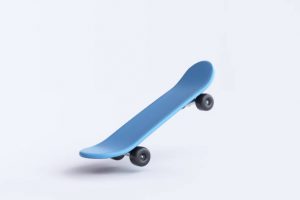
Purchasing Skateboard Deck
After carefully evaluating your options, it’s time to finally make that exciting purchase. Should you buy online or in-store? Shopping online often offers more variety and convenience for buyers, but in-store purchasing lets buyers physically inspect the skateboard deck before purchasing. Just remember to consider the size, shape, wheels, and materials.
When purchasing a skateboard, it’s essential to choose the right combination of components, considering wider boards for stability and soft wheels for smooth landings when practicing tricks. Following the general buying guide on skateboard wheels and width ensures a safer and more enjoyable riding experience.
- Consider Your Skill Level: Before purchasing a skateboard, assess your skill level. Beginners may prefer wider decks skateboard and more stable skateboards for better balance, while advanced skaters might opt for narrower skateboards for increased maneuverability. Choose a skateboard that suits your current abilities and allows room for growth as you progress.
- Deck Size and Shape (Skateboard Chart Size): The size and shape of the skateboard deck significantly impact your riding experience. Decks come in various widths, typically ranging from 7.5 to 8.5 inches. A wider deck offers more stability, whereas a narrower one allows for quicker turns and tricks. Additionally, consider the deck’s concave (curvature), as it influences your foot placement and control.
- Skateboard trucks are the metal T-shaped components that hold the wheels. For optimal skateboard stability, the width of the skateboard trucks should match the width of your deck. Consider the truck height as well—low trucks provide more skateboard stability, while high trucks offer better clearance for tricks. Quality trucks with durable materials and responsive turning mechanisms contribute to a smoother ride.
- Skateboard wheels come in different sizes and hardness levels. Larger wheels provide a smoother ride over rough terrain, while smaller wheels offer better maneuverability for tricks. Wheel hardness is measured on the durometer scale; softer wheels (lower durometer) provide better grip, while harder wheels (higher durometer) are more suitable for smooth surfaces and slides. Choose the wheel size and hardness based on your preferred riding style of skating and the type of terrain you’ll be riding on.
- Remember, personal skateboard preferences play a significant role in choosing the right skateboard. If possible, try out different skateboard setups or seek advice from experienced skateboard enthusiasts before making a final decision.

Conclusion
The best thing to remember is to choose a board that feels right and is suitable for your riding style. Moreover, try to consider the width, deck length, and shape of the decks, as well as your height and shoe size, when choosing the right board. Larger wheels and softer bearings are good for cruising or downhill racing, while harder wheels are better for street skating. Additionally, check the type of trucks, wood curves, mounting holes, and other parts and accessories when you shop for a complete board. Whether you’re a new skater or an experienced one, finding the right longboard or cruiser can make all the difference.
Don’t forget to explore different brands and sizes, and consider adding personal preference on clothing including hats & beanies, shoe size, and more to complete your skate style. Moreover, you need to consider how skateboards perform. A smaller skateboard deck and different riding styles affect your board’s performance. Choosing the right skate deck involves considering your shoe size, skateboard deck width, street skating preferences, and personal preference. Remember that skate decks come in various deck widths and shapes, so take the time to find one that fits your clothing accessories, skate shoes, street skating style, and needs perfectly.
From the nose tail to the grip tape, every detail matters. Whether you’re practicing on ramps & rails or finding your starting point, your board’s specs will influence your performance. Don’t forget that shirts & hoodies are part of your skate style too, so make sure they match your gear and preferences.

Frequently Asked Questions (FAQs)
What Do Skaters Call Normal Skateboards?
Normal skateboards are often referred to as “skateboard decks” or simply “decks.”
What Size Skateboard Decks Do Skaters Need?
The size of the skateboard decks skaters need depends on shoe size and skating preferences. When choosing a skateboard deck and a new board, skaters often find that longer decks made of wood are ideal. Cruiser boards with deck widths between 8.25 and 8.5 inches are popular choices for many skaters.
Decks skateboard and skate deck terminology can sometimes be confusing, but understanding the basics will help beginners make a more informed decision. Clothing accessories like skate shoes, pads, and helmets, also contribute to a safer and more enjoyable wider decks skating experience. Decks trucks, the metal T-shaped pieces that attach the wheels to the skate deck, should be chosen based on the skate deck width to ensure optimal street skating performance with wider decks trucks.
How Do I Know If My Skateboard Deck Is Good?
A good skateboard deck is typically made of quality materials like maple wood, which provides durability and pop for tricks like flip tricks. When choosing a deck, consider the deck length to ensure it matches your height and shoe size for optimal control. Additionally, quality grip tape is essential for providing the traction needed to perform tricks effectively.
How Do I Know What Size Of Board To Get?
Consider your shoe size to determine the right skateboard width. For individuals with larger feet, a wider deck is recommended for better control during flip tricks and riding. Choosing the right shoe size depends on your personal preferences, riding style, and body size. Generally, skateboard sizes are determined by the width of the deck, measured in inches. There are various types of decks, including those with a flat profile or a concave shape, each offering different levels of control and maneuverability. The standard deck width for most skaters ranges from 7.5 to 8.5 inches, but you may need a new deck size based on your specific needs and preferences.
Is There A Difference Between Skateboard Decks?
Yes, there are differences between skateboard decks, mainly in terms of width, length, concave, and construction materials. Choose skate decks that suit your skateboarding style. The primary distinctions lie in the shape, concave, and dimensions.
How Many Plys Should A Skateboard Be?
A standard skateboard deck usually consists of 7 to 9 pieces of maple wood. The number of plies affects the deck’s strength and flexibility. Seven-ply boards are the most common. The number of plies directly affects strength, flexibility, and overall performance.
How Do I Know If A Skateboard Is Real?
When purchasing a skateboard, especially online or from unknown sources, be cautious of counterfeit products. Determine the authenticity of a skateboard by examining various elements, especially when purchasing from a different brand or reputable source.
What Is The Difference Between Cheap And Expensive Skate Decks?
A cheap longboard may use lower-quality materials, leading to decreased durability and performance. Even so, this doesn’t mean that you cannot purchase a cheap one. Budget-friendly skateboards are there for a reason, and if you can find the best one, you will not regret it.
Does Your Choice Of Clothing Affect Your Skateboarding Experience?
